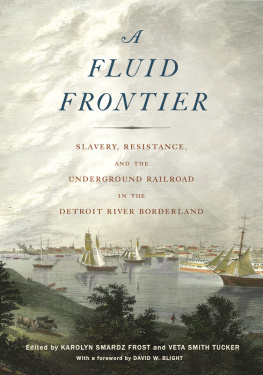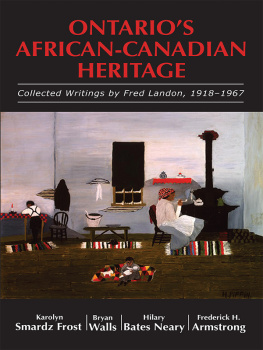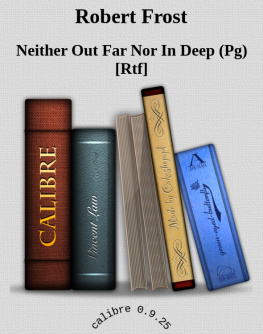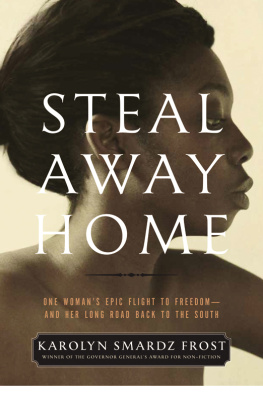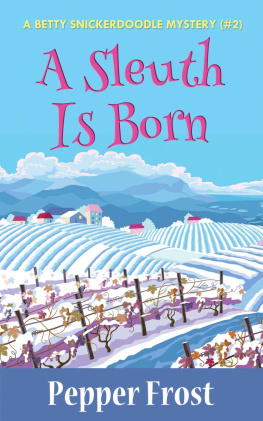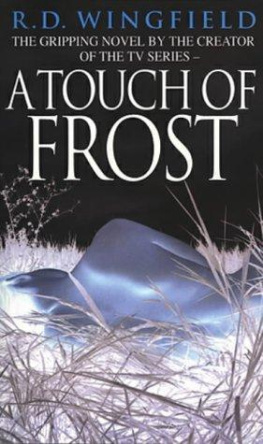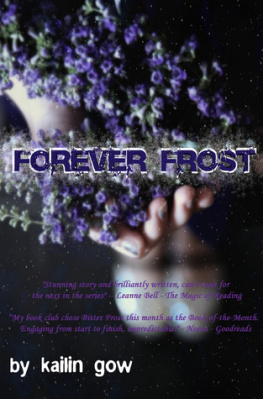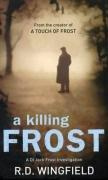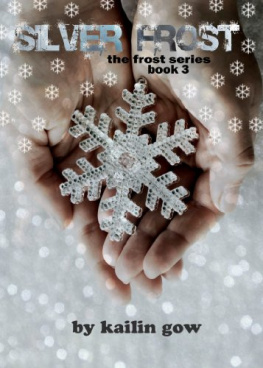Karolyn Smardz Frost - A Fluid Frontier
Here you can read online Karolyn Smardz Frost - A Fluid Frontier full text of the book (entire story) in english for free. Download pdf and epub, get meaning, cover and reviews about this ebook. publisher: Wayne State University Press, genre: Politics. Description of the work, (preface) as well as reviews are available. Best literature library LitArk.com created for fans of good reading and offers a wide selection of genres:
Romance novel
Science fiction
Adventure
Detective
Science
History
Home and family
Prose
Art
Politics
Computer
Non-fiction
Religion
Business
Children
Humor
Choose a favorite category and find really read worthwhile books. Enjoy immersion in the world of imagination, feel the emotions of the characters or learn something new for yourself, make an fascinating discovery.
- Book:A Fluid Frontier
- Author:
- Publisher:Wayne State University Press
- Genre:
- Rating:4 / 5
- Favourites:Add to favourites
- Your mark:
- 80
- 1
- 2
- 3
- 4
- 5
A Fluid Frontier: summary, description and annotation
We offer to read an annotation, description, summary or preface (depends on what the author of the book "A Fluid Frontier" wrote himself). If you haven't found the necessary information about the book — write in the comments, we will try to find it.
A Fluid Frontier — read online for free the complete book (whole text) full work
Below is the text of the book, divided by pages. System saving the place of the last page read, allows you to conveniently read the book "A Fluid Frontier" online for free, without having to search again every time where you left off. Put a bookmark, and you can go to the page where you finished reading at any time.
Font size:
Interval:
Bookmark:

GREAT LAKES BOOKS
Editor
Charles K. Hyde, Wayne State University
Advisory Editors
Jeffrey Abt, Wayne State University
Fredric C. Bohm, Michigan State University
Sandra Sageser Clark, Michigan Historical Center
Brian Leigh Dunnigan, Clements Library
De Witt Dykes, Oakland University
Joe Grimm, Michigan State University
Richard H. Harms, Calvin College
Laurie Harris, Pleasant Ridge, Michigan
Thomas Klug, Marygrove College
Susan Higman Larsen, Detroit Institute of Arts
Philip P. Mason, Prescott, Arizona and Eagle Harbor, Michigan
Dennis Moore, Consulate General of Canada
Erik C. Nordberg, Michigan Humanities Council
Deborah Smith Pollard, University of MichiganDearborn
Michael O. Smith, Wayne State University
Joseph M. Turrini, Wayne State University
Arthur M. Woodford, Harsens Island, Michigan
A complete listing of the books in this series can be found online at wsupress.wayne.edu
A
FLUID
FRONTIER
SLAVERY, RESISTANCE,
AND THE
UNDERGROUND RAILROAD
IN THE
DETROIT RIVER BORDERLAND
Edited by KAROLYN SMARDZ FROST and VETA SMITH TUCKER
With a foreword by DAVID W. BLIGHT

2016 by Wayne State University Press, Detroit, Michigan 48201.
All rights reserved. No part of this book may be reproduced without formal permission.
Manufactured in the United States of America.
20 19 18 17 16 5 4 3 2 1
Library of Congress Control Number: 2015946924
ISBN 978-0-8143-3959-6 (paperback)
ISBN 978-0-8143-3960-2 (ebook)
Published with support from the Arthur L. Johnson Fund for African American Studies.

Designed and typeset by Bryce Schimanski
Composed in Adobe Caslon Pro
If I have seen further it is by standing on the shoulders of giants.
Sir Isaac Newton
We dedicate A Fluid Frontier to two giants, one American the other Canadian. Their insights on the Detroit River region influenced our thinking and motivated us to finish this project. To the late Dr. Norman McRae Jr. (19252010), historian, author, and educator, whose scholarship and dedication to truth continue to have a profound influence on both academic and popular perceptions of African American history in Detroit, Michigan, and to Dr. Daniel G. Hill, historian, sociologist, civil rights activist, and Chairman of the Ontario Human Rights Commission, whose research in the study of the African Canadian past will inspire scholars and students alike for generations to come.
CONTENTS
by David W. Blight
KAROLYN SMARDZ FROST AND VETA SMITH TUCKER
VETA SMITH TUCKER
KAROLYN SMARDZ FROST
BRYAN PRINCE
IRENE MOORE DAVIS
BARBARA HUGHES SMITH
ADRIENNE SHADD
AFUA COOPER
ROY FINKENBINE
MARGARET WASHINGTON
KIMBERLY SIMMONS AND LARRY MCCLELLAN
DEBIAN MARTY
CAROL E. MULL
LOUIS A. DECARO JR.
KAROLYN SMARDZ FROST AND VETA SMITH TUCKER
ACKNOWLEDGMENTS
For their unconditional love and support while we labored to complete A Fluid Frontier, we are grateful to Norm Frost, and all our family members and close friends; for their diligent research and excellent writing, we thank the twelve authors whose chapters give this volume life; and for her insightful editorial review, we thank Dr. Alisea McLeod. For kind and competent assistance from every librarian and archivist we consulted throughout the Midwest and Canada, we thank all of you.
For their remarkable generosity in sharing with us the findings of their ongoing research in African Canadian history, we thank Hilary Dawson, Natasha Henry, and Guylaine Petrin. For taking stunning photographs exclusively for this volume, we thank Elizabeth Clark of Detroit; and for their assiduous editorial support and encouragement, we thank the editor-in chief of Wayne State University Press, Kathryn Wildfong, and her dedicated staff.
Finally, to those who supported us with and without our knowledge, whose names may not be listed here, it is also because of you that we were able to complete this book.
FOREWORD
I grew up in Flint, Michigan, an easy drive northwest of Detroit, in the 1950s and 1960s. I was fortunate to be taught by two excellent high school history teachers, one in Western Civilization and the other in U. S. History. But I never learned anything about this epic, harrowing, and inspiring story of the Underground Railroad in the Detroit River region. I am grateful for two degrees in history from Michigan State University, where in the late 1960s I took the first course ever offered there in black history, taught by the late Leslie Rout. To say the least, I came to love history. I taught American history in the Flint Public Schools for seven years in the 1970s, and have practiced the craft as a scholar now for more than three decades. Countless times I traveled to the Motor City for all manner of eventssports, culture, road races on Belle Isle in the middle of the Detroit River.
But I never learned about the many thousands gone who had by so many paths over long journeys crossed over from the docks of Detroit to the shores of Windsor or Amherstburg. No one or no thing in particular is to blame for my lack of knowledge in these formative years. Great shifts and revolutions in historical knowledge take time and events to force them to the fore. But what a remarkable history and cultural memory was there in my youth hiding in plain sight. And that rich, profound historya living historyis brought to life in this collection of essays about the people, the communities, the personalities, the places, and the institutions forged from the late eighteenth century through the Civil War. The Detroit River borderland was for decades a teeming, thriving landscape and waterscape by which thousands of African Americans became African Canadians or both. That story is now poignantly memorialized in monuments on both sides of the river.
In a recent important book, Eric Foner has shown how the Metropolitan Corridor, the region connecting the Vigilance Committees of Philadelphia and New York City, and funneling fugitives slaves particularly out of Maryland and Delaware to New York and beyond, operated with great energy, both open and covert, in the 1850s.and the Underground Railroad in the Detroit River Borderland the story of how the Detroit RiverCanadian border region was every bit as large and important as a place and a system through which African American former slaves found degrees of freedom. This books research and scope, the poignant new stories it tells, and especially its international, borderlands approach ought to advance any effort to achieve a World Heritage designation for the Detroit River region. The Underground Railroad along this international border functioned both overtly and covertly as well as outside or in resistance to the law. Its leaders, like Henry and Mary Bibb and so many others, were full-throated revolutionaries; the people they assisted have millions of descendants today of all human colors and backgrounds in Canada, the United States, and other countries.
I witnessed the beauty and character of that diaspora several years ago as a very fortunate invited speaker at a conference on the Underground Railroad in Canada on the eve of the annual Buxton Homecoming, an event that those of us in the United States have to see to believe. Each year on Labour Day weekend, for four days, descendants and extended families from far-flung places come to the small town of Buxton, Ontario, a mere hours drive east of Detroit. They camp out all over the agricultural landscape and commune with their own illusive but suddenly real past at the North Buxton Community Church and graveyard, as well as at the extraordinary Buxton National Historic Site and Museum. They come to learn about and celebrate the original fugitive slaves who settled in that community and built its great farming traditions. They also conduct spirited family baseball and softball tournaments. But I can attest that, as a historian of this subject, I have had few experiences as moving and special as the hayride and food fest hosted and led by Bryan and Shannon Prince. Bryan is himself a distinguished historian, direct descendant of Buxton founders, and a successful local farmer. The annual Buxton Homecoming, the ninetieth annual of which was held in 2013 and drew more than three thousand people, is a living legacy of the difficult but inspiring story represented by this book.
Next pageFont size:
Interval:
Bookmark:
Similar books «A Fluid Frontier»
Look at similar books to A Fluid Frontier. We have selected literature similar in name and meaning in the hope of providing readers with more options to find new, interesting, not yet read works.
Discussion, reviews of the book A Fluid Frontier and just readers' own opinions. Leave your comments, write what you think about the work, its meaning or the main characters. Specify what exactly you liked and what you didn't like, and why you think so.

